Change Management Strategies for HP Group in Hospitality Sector
VerifiedAdded on 2022/09/09
|16
|3119
|19
Report
AI Summary
This report provides a comprehensive analysis of change management strategies within the hospitality industry, specifically focusing on the HP Group's acquisition of Ferns hotels. The report delves into the issues of organizational culture, examining the clash between the American HP Group's culture and the existing culture of Ferns hotels in New Zealand. It highlights the failures in communication, lack of employee engagement, and disregard for local culture that led to significant problems. Furthermore, the report explores organizational development and its importance in managing change, emphasizing the need for a bi-cultural approach. A detailed change management action plan, based on Lewin's change model, is proposed to address the challenges, including formal inductions, staff meetings, and team-building exercises. Finally, the report evaluates the role of organizational structure in meeting organizational goals, offering recommendations for HP Group to improve its change management processes and achieve its objectives. The report also includes an analysis of various organizational structures, such as centralization, decentralization, functional, divisional, matrix, contemporary team and virtual structures, evaluating their advantages and disadvantages.
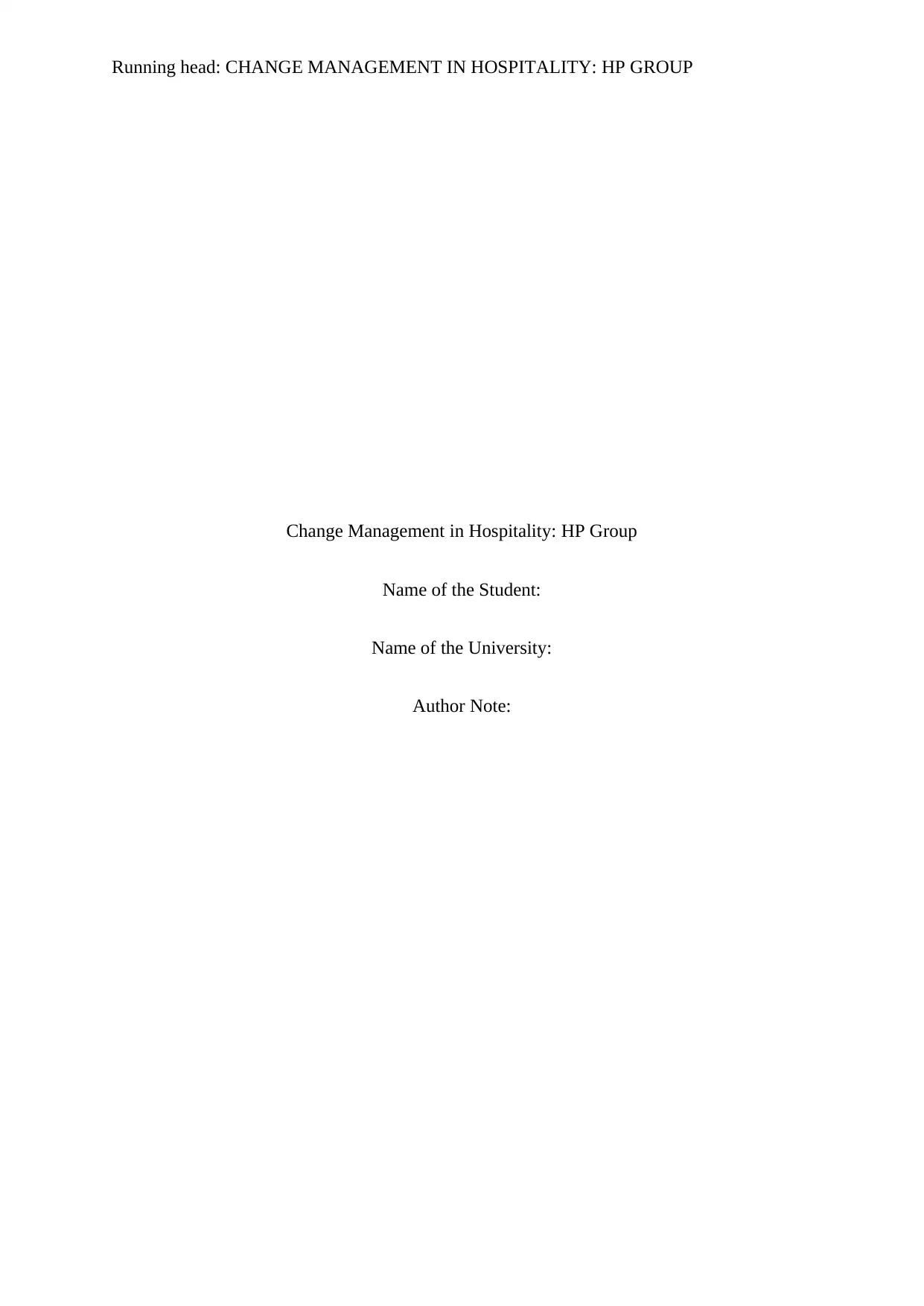
Running head: CHANGE MANAGEMENT IN HOSPITALITY: HP GROUP
Change Management in Hospitality: HP Group
Name of the Student:
Name of the University:
Author Note:
Change Management in Hospitality: HP Group
Name of the Student:
Name of the University:
Author Note:
Paraphrase This Document
Need a fresh take? Get an instant paraphrase of this document with our AI Paraphraser
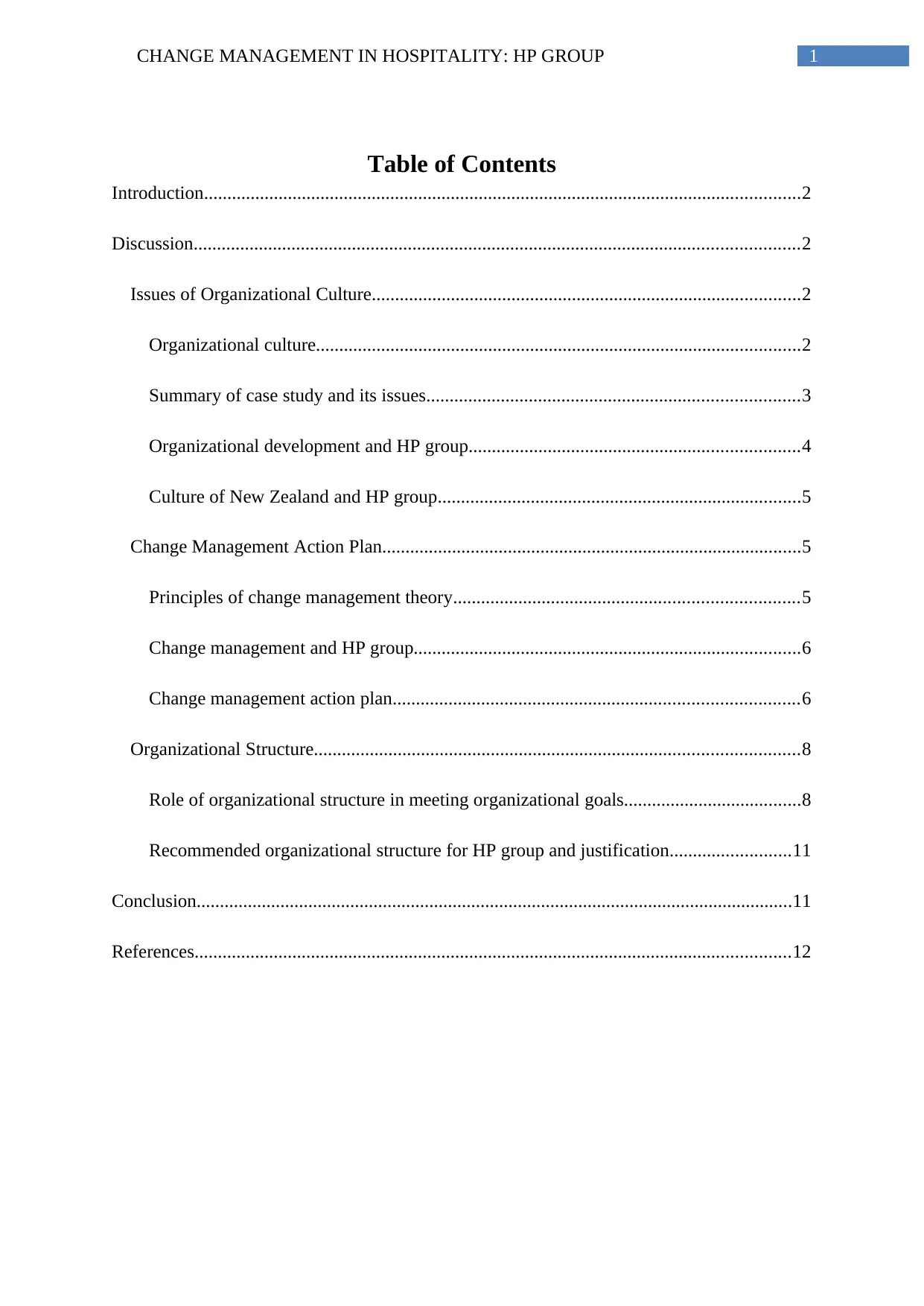
1CHANGE MANAGEMENT IN HOSPITALITY: HP GROUP
Table of Contents
Introduction................................................................................................................................2
Discussion..................................................................................................................................2
Issues of Organizational Culture............................................................................................2
Organizational culture........................................................................................................2
Summary of case study and its issues................................................................................3
Organizational development and HP group.......................................................................4
Culture of New Zealand and HP group..............................................................................5
Change Management Action Plan..........................................................................................5
Principles of change management theory..........................................................................5
Change management and HP group...................................................................................6
Change management action plan.......................................................................................6
Organizational Structure........................................................................................................8
Role of organizational structure in meeting organizational goals......................................8
Recommended organizational structure for HP group and justification..........................11
Conclusion................................................................................................................................11
References................................................................................................................................12
Table of Contents
Introduction................................................................................................................................2
Discussion..................................................................................................................................2
Issues of Organizational Culture............................................................................................2
Organizational culture........................................................................................................2
Summary of case study and its issues................................................................................3
Organizational development and HP group.......................................................................4
Culture of New Zealand and HP group..............................................................................5
Change Management Action Plan..........................................................................................5
Principles of change management theory..........................................................................5
Change management and HP group...................................................................................6
Change management action plan.......................................................................................6
Organizational Structure........................................................................................................8
Role of organizational structure in meeting organizational goals......................................8
Recommended organizational structure for HP group and justification..........................11
Conclusion................................................................................................................................11
References................................................................................................................................12
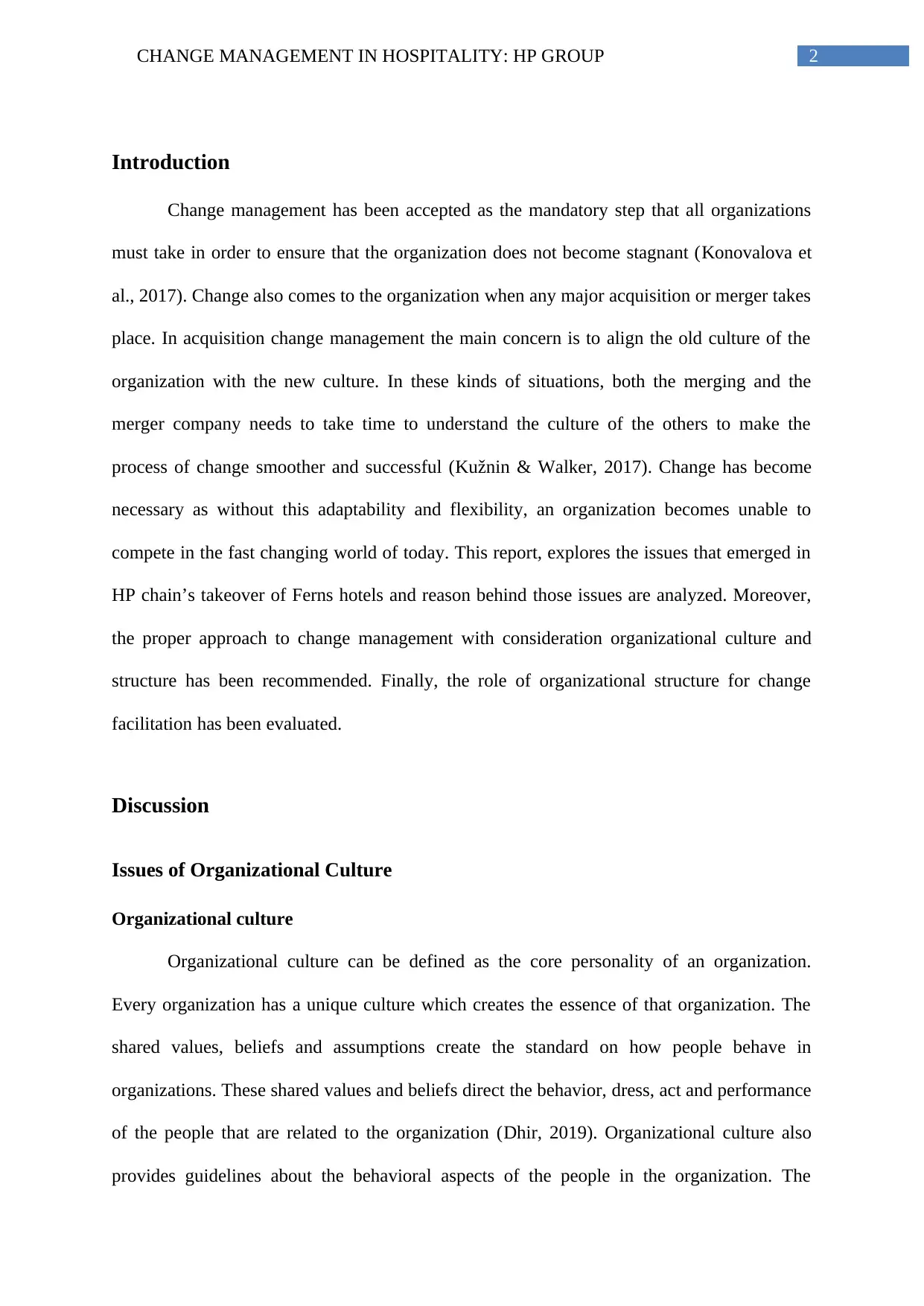
2CHANGE MANAGEMENT IN HOSPITALITY: HP GROUP
Introduction
Change management has been accepted as the mandatory step that all organizations
must take in order to ensure that the organization does not become stagnant (Konovalova et
al., 2017). Change also comes to the organization when any major acquisition or merger takes
place. In acquisition change management the main concern is to align the old culture of the
organization with the new culture. In these kinds of situations, both the merging and the
merger company needs to take time to understand the culture of the others to make the
process of change smoother and successful (Kužnin & Walker, 2017). Change has become
necessary as without this adaptability and flexibility, an organization becomes unable to
compete in the fast changing world of today. This report, explores the issues that emerged in
HP chain’s takeover of Ferns hotels and reason behind those issues are analyzed. Moreover,
the proper approach to change management with consideration organizational culture and
structure has been recommended. Finally, the role of organizational structure for change
facilitation has been evaluated.
Discussion
Issues of Organizational Culture
Organizational culture
Organizational culture can be defined as the core personality of an organization.
Every organization has a unique culture which creates the essence of that organization. The
shared values, beliefs and assumptions create the standard on how people behave in
organizations. These shared values and beliefs direct the behavior, dress, act and performance
of the people that are related to the organization (Dhir, 2019). Organizational culture also
provides guidelines about the behavioral aspects of the people in the organization. The
Introduction
Change management has been accepted as the mandatory step that all organizations
must take in order to ensure that the organization does not become stagnant (Konovalova et
al., 2017). Change also comes to the organization when any major acquisition or merger takes
place. In acquisition change management the main concern is to align the old culture of the
organization with the new culture. In these kinds of situations, both the merging and the
merger company needs to take time to understand the culture of the others to make the
process of change smoother and successful (Kužnin & Walker, 2017). Change has become
necessary as without this adaptability and flexibility, an organization becomes unable to
compete in the fast changing world of today. This report, explores the issues that emerged in
HP chain’s takeover of Ferns hotels and reason behind those issues are analyzed. Moreover,
the proper approach to change management with consideration organizational culture and
structure has been recommended. Finally, the role of organizational structure for change
facilitation has been evaluated.
Discussion
Issues of Organizational Culture
Organizational culture
Organizational culture can be defined as the core personality of an organization.
Every organization has a unique culture which creates the essence of that organization. The
shared values, beliefs and assumptions create the standard on how people behave in
organizations. These shared values and beliefs direct the behavior, dress, act and performance
of the people that are related to the organization (Dhir, 2019). Organizational culture also
provides guidelines about the behavioral aspects of the people in the organization. The
⊘ This is a preview!⊘
Do you want full access?
Subscribe today to unlock all pages.

Trusted by 1+ million students worldwide
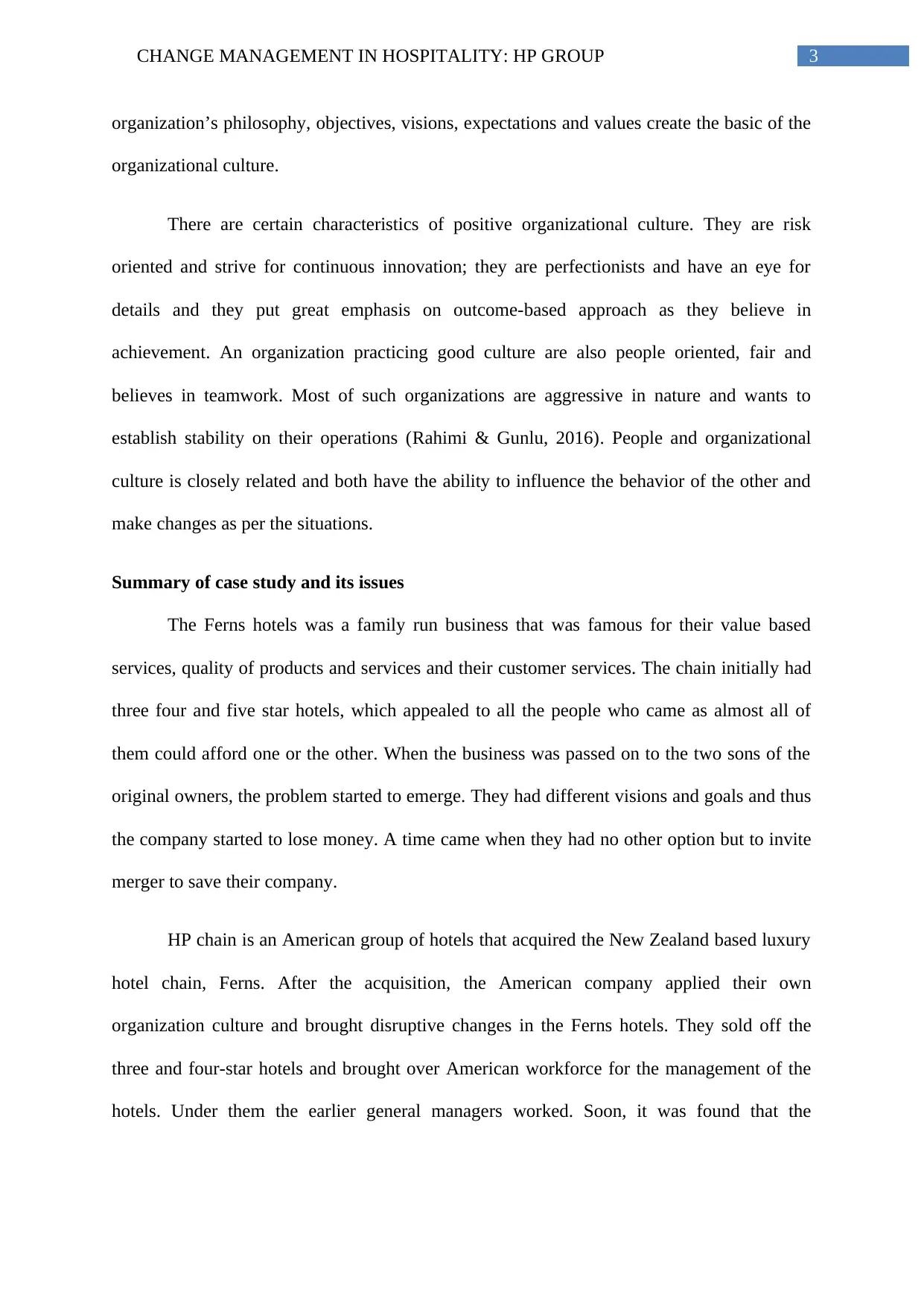
3CHANGE MANAGEMENT IN HOSPITALITY: HP GROUP
organization’s philosophy, objectives, visions, expectations and values create the basic of the
organizational culture.
There are certain characteristics of positive organizational culture. They are risk
oriented and strive for continuous innovation; they are perfectionists and have an eye for
details and they put great emphasis on outcome-based approach as they believe in
achievement. An organization practicing good culture are also people oriented, fair and
believes in teamwork. Most of such organizations are aggressive in nature and wants to
establish stability on their operations (Rahimi & Gunlu, 2016). People and organizational
culture is closely related and both have the ability to influence the behavior of the other and
make changes as per the situations.
Summary of case study and its issues
The Ferns hotels was a family run business that was famous for their value based
services, quality of products and services and their customer services. The chain initially had
three four and five star hotels, which appealed to all the people who came as almost all of
them could afford one or the other. When the business was passed on to the two sons of the
original owners, the problem started to emerge. They had different visions and goals and thus
the company started to lose money. A time came when they had no other option but to invite
merger to save their company.
HP chain is an American group of hotels that acquired the New Zealand based luxury
hotel chain, Ferns. After the acquisition, the American company applied their own
organization culture and brought disruptive changes in the Ferns hotels. They sold off the
three and four-star hotels and brought over American workforce for the management of the
hotels. Under them the earlier general managers worked. Soon, it was found that the
organization’s philosophy, objectives, visions, expectations and values create the basic of the
organizational culture.
There are certain characteristics of positive organizational culture. They are risk
oriented and strive for continuous innovation; they are perfectionists and have an eye for
details and they put great emphasis on outcome-based approach as they believe in
achievement. An organization practicing good culture are also people oriented, fair and
believes in teamwork. Most of such organizations are aggressive in nature and wants to
establish stability on their operations (Rahimi & Gunlu, 2016). People and organizational
culture is closely related and both have the ability to influence the behavior of the other and
make changes as per the situations.
Summary of case study and its issues
The Ferns hotels was a family run business that was famous for their value based
services, quality of products and services and their customer services. The chain initially had
three four and five star hotels, which appealed to all the people who came as almost all of
them could afford one or the other. When the business was passed on to the two sons of the
original owners, the problem started to emerge. They had different visions and goals and thus
the company started to lose money. A time came when they had no other option but to invite
merger to save their company.
HP chain is an American group of hotels that acquired the New Zealand based luxury
hotel chain, Ferns. After the acquisition, the American company applied their own
organization culture and brought disruptive changes in the Ferns hotels. They sold off the
three and four-star hotels and brought over American workforce for the management of the
hotels. Under them the earlier general managers worked. Soon, it was found that the
Paraphrase This Document
Need a fresh take? Get an instant paraphrase of this document with our AI Paraphraser
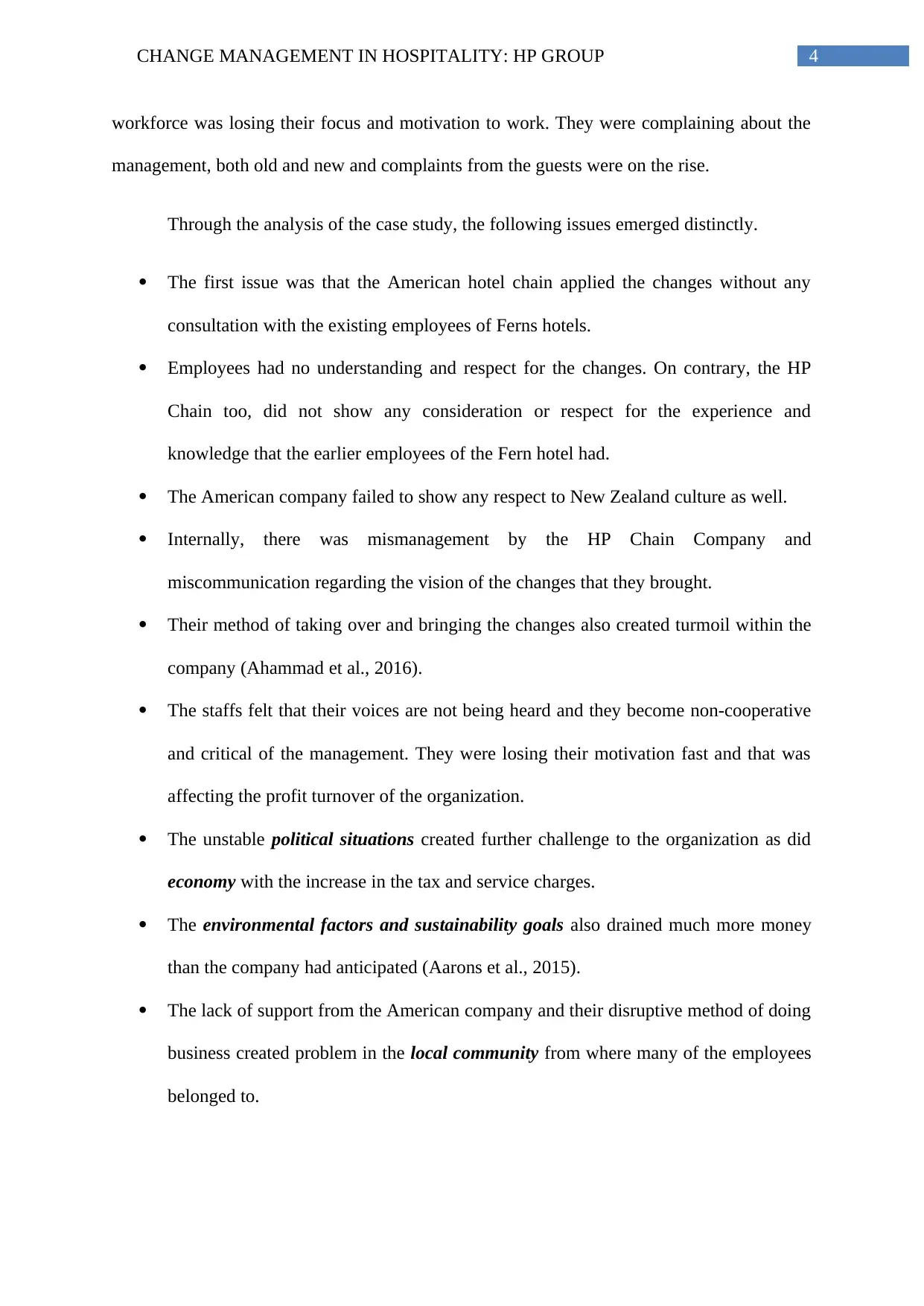
4CHANGE MANAGEMENT IN HOSPITALITY: HP GROUP
workforce was losing their focus and motivation to work. They were complaining about the
management, both old and new and complaints from the guests were on the rise.
Through the analysis of the case study, the following issues emerged distinctly.
The first issue was that the American hotel chain applied the changes without any
consultation with the existing employees of Ferns hotels.
Employees had no understanding and respect for the changes. On contrary, the HP
Chain too, did not show any consideration or respect for the experience and
knowledge that the earlier employees of the Fern hotel had.
The American company failed to show any respect to New Zealand culture as well.
Internally, there was mismanagement by the HP Chain Company and
miscommunication regarding the vision of the changes that they brought.
Their method of taking over and bringing the changes also created turmoil within the
company (Ahammad et al., 2016).
The staffs felt that their voices are not being heard and they become non-cooperative
and critical of the management. They were losing their motivation fast and that was
affecting the profit turnover of the organization.
The unstable political situations created further challenge to the organization as did
economy with the increase in the tax and service charges.
The environmental factors and sustainability goals also drained much more money
than the company had anticipated (Aarons et al., 2015).
The lack of support from the American company and their disruptive method of doing
business created problem in the local community from where many of the employees
belonged to.
workforce was losing their focus and motivation to work. They were complaining about the
management, both old and new and complaints from the guests were on the rise.
Through the analysis of the case study, the following issues emerged distinctly.
The first issue was that the American hotel chain applied the changes without any
consultation with the existing employees of Ferns hotels.
Employees had no understanding and respect for the changes. On contrary, the HP
Chain too, did not show any consideration or respect for the experience and
knowledge that the earlier employees of the Fern hotel had.
The American company failed to show any respect to New Zealand culture as well.
Internally, there was mismanagement by the HP Chain Company and
miscommunication regarding the vision of the changes that they brought.
Their method of taking over and bringing the changes also created turmoil within the
company (Ahammad et al., 2016).
The staffs felt that their voices are not being heard and they become non-cooperative
and critical of the management. They were losing their motivation fast and that was
affecting the profit turnover of the organization.
The unstable political situations created further challenge to the organization as did
economy with the increase in the tax and service charges.
The environmental factors and sustainability goals also drained much more money
than the company had anticipated (Aarons et al., 2015).
The lack of support from the American company and their disruptive method of doing
business created problem in the local community from where many of the employees
belonged to.
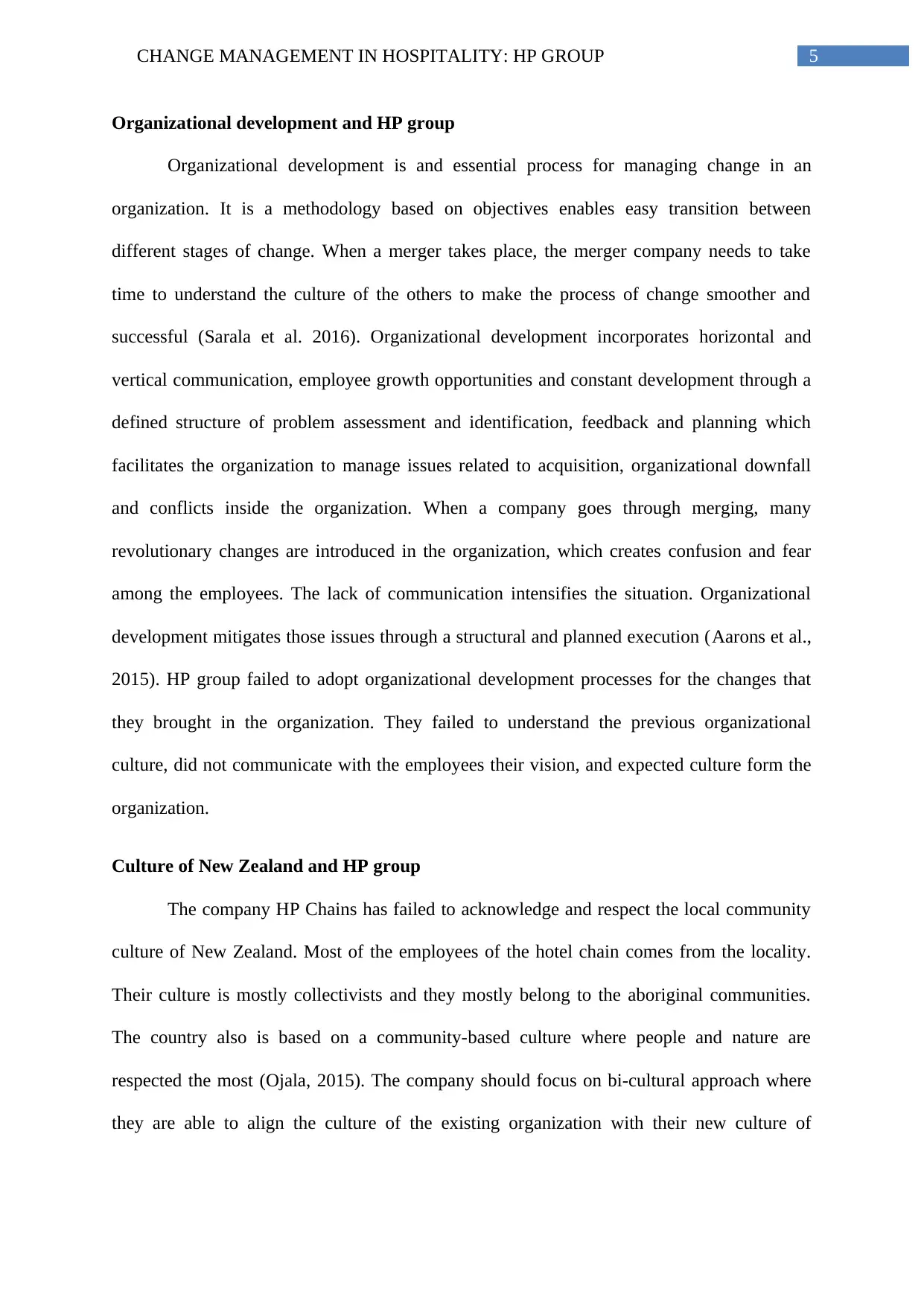
5CHANGE MANAGEMENT IN HOSPITALITY: HP GROUP
Organizational development and HP group
Organizational development is and essential process for managing change in an
organization. It is a methodology based on objectives enables easy transition between
different stages of change. When a merger takes place, the merger company needs to take
time to understand the culture of the others to make the process of change smoother and
successful (Sarala et al. 2016). Organizational development incorporates horizontal and
vertical communication, employee growth opportunities and constant development through a
defined structure of problem assessment and identification, feedback and planning which
facilitates the organization to manage issues related to acquisition, organizational downfall
and conflicts inside the organization. When a company goes through merging, many
revolutionary changes are introduced in the organization, which creates confusion and fear
among the employees. The lack of communication intensifies the situation. Organizational
development mitigates those issues through a structural and planned execution (Aarons et al.,
2015). HP group failed to adopt organizational development processes for the changes that
they brought in the organization. They failed to understand the previous organizational
culture, did not communicate with the employees their vision, and expected culture form the
organization.
Culture of New Zealand and HP group
The company HP Chains has failed to acknowledge and respect the local community
culture of New Zealand. Most of the employees of the hotel chain comes from the locality.
Their culture is mostly collectivists and they mostly belong to the aboriginal communities.
The country also is based on a community-based culture where people and nature are
respected the most (Ojala, 2015). The company should focus on bi-cultural approach where
they are able to align the culture of the existing organization with their new culture of
Organizational development and HP group
Organizational development is and essential process for managing change in an
organization. It is a methodology based on objectives enables easy transition between
different stages of change. When a merger takes place, the merger company needs to take
time to understand the culture of the others to make the process of change smoother and
successful (Sarala et al. 2016). Organizational development incorporates horizontal and
vertical communication, employee growth opportunities and constant development through a
defined structure of problem assessment and identification, feedback and planning which
facilitates the organization to manage issues related to acquisition, organizational downfall
and conflicts inside the organization. When a company goes through merging, many
revolutionary changes are introduced in the organization, which creates confusion and fear
among the employees. The lack of communication intensifies the situation. Organizational
development mitigates those issues through a structural and planned execution (Aarons et al.,
2015). HP group failed to adopt organizational development processes for the changes that
they brought in the organization. They failed to understand the previous organizational
culture, did not communicate with the employees their vision, and expected culture form the
organization.
Culture of New Zealand and HP group
The company HP Chains has failed to acknowledge and respect the local community
culture of New Zealand. Most of the employees of the hotel chain comes from the locality.
Their culture is mostly collectivists and they mostly belong to the aboriginal communities.
The country also is based on a community-based culture where people and nature are
respected the most (Ojala, 2015). The company should focus on bi-cultural approach where
they are able to align the culture of the existing organization with their new culture of
⊘ This is a preview!⊘
Do you want full access?
Subscribe today to unlock all pages.

Trusted by 1+ million students worldwide
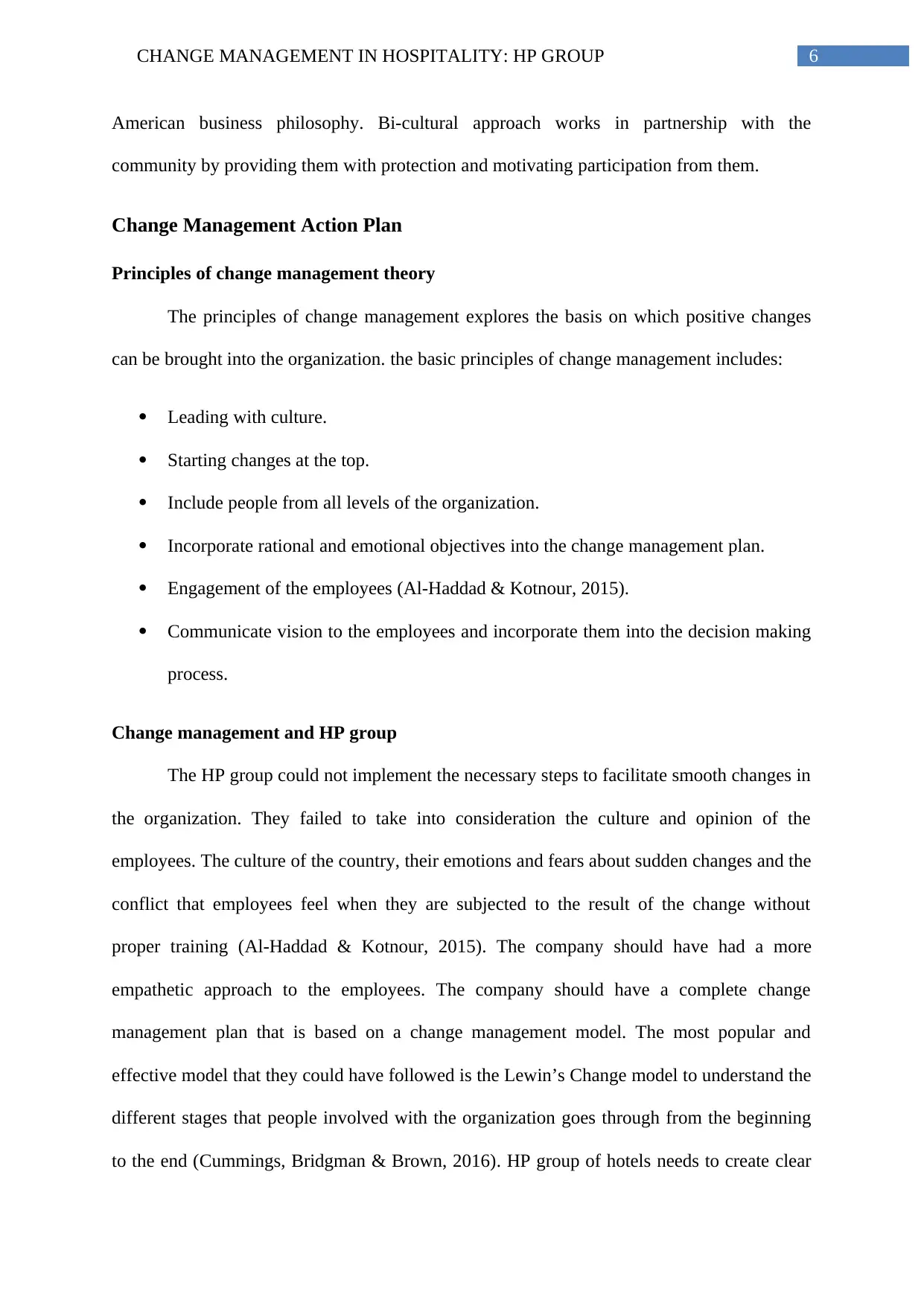
6CHANGE MANAGEMENT IN HOSPITALITY: HP GROUP
American business philosophy. Bi-cultural approach works in partnership with the
community by providing them with protection and motivating participation from them.
Change Management Action Plan
Principles of change management theory
The principles of change management explores the basis on which positive changes
can be brought into the organization. the basic principles of change management includes:
Leading with culture.
Starting changes at the top.
Include people from all levels of the organization.
Incorporate rational and emotional objectives into the change management plan.
Engagement of the employees (Al-Haddad & Kotnour, 2015).
Communicate vision to the employees and incorporate them into the decision making
process.
Change management and HP group
The HP group could not implement the necessary steps to facilitate smooth changes in
the organization. They failed to take into consideration the culture and opinion of the
employees. The culture of the country, their emotions and fears about sudden changes and the
conflict that employees feel when they are subjected to the result of the change without
proper training (Al-Haddad & Kotnour, 2015). The company should have had a more
empathetic approach to the employees. The company should have a complete change
management plan that is based on a change management model. The most popular and
effective model that they could have followed is the Lewin’s Change model to understand the
different stages that people involved with the organization goes through from the beginning
to the end (Cummings, Bridgman & Brown, 2016). HP group of hotels needs to create clear
American business philosophy. Bi-cultural approach works in partnership with the
community by providing them with protection and motivating participation from them.
Change Management Action Plan
Principles of change management theory
The principles of change management explores the basis on which positive changes
can be brought into the organization. the basic principles of change management includes:
Leading with culture.
Starting changes at the top.
Include people from all levels of the organization.
Incorporate rational and emotional objectives into the change management plan.
Engagement of the employees (Al-Haddad & Kotnour, 2015).
Communicate vision to the employees and incorporate them into the decision making
process.
Change management and HP group
The HP group could not implement the necessary steps to facilitate smooth changes in
the organization. They failed to take into consideration the culture and opinion of the
employees. The culture of the country, their emotions and fears about sudden changes and the
conflict that employees feel when they are subjected to the result of the change without
proper training (Al-Haddad & Kotnour, 2015). The company should have had a more
empathetic approach to the employees. The company should have a complete change
management plan that is based on a change management model. The most popular and
effective model that they could have followed is the Lewin’s Change model to understand the
different stages that people involved with the organization goes through from the beginning
to the end (Cummings, Bridgman & Brown, 2016). HP group of hotels needs to create clear
Paraphrase This Document
Need a fresh take? Get an instant paraphrase of this document with our AI Paraphraser
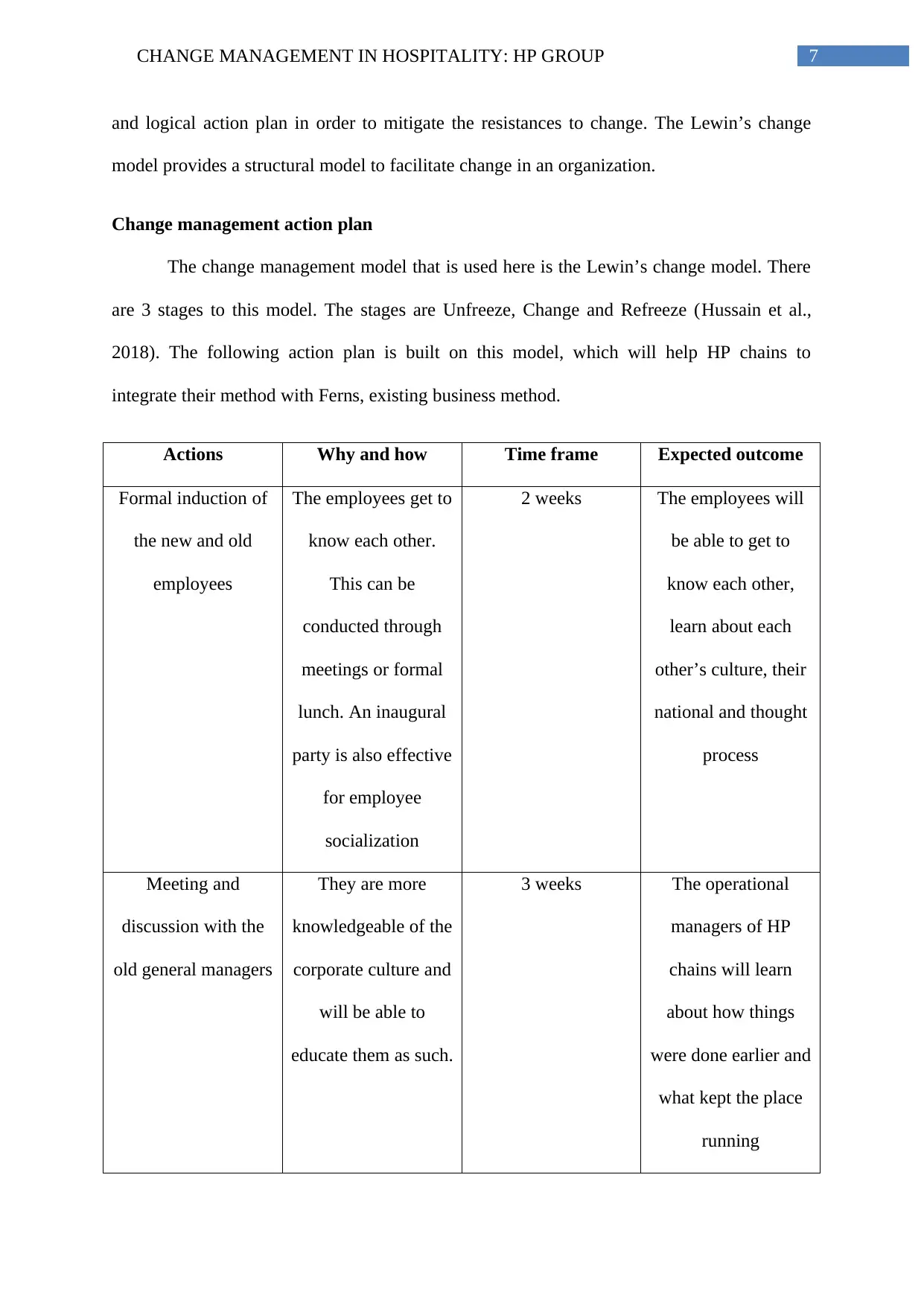
7CHANGE MANAGEMENT IN HOSPITALITY: HP GROUP
and logical action plan in order to mitigate the resistances to change. The Lewin’s change
model provides a structural model to facilitate change in an organization.
Change management action plan
The change management model that is used here is the Lewin’s change model. There
are 3 stages to this model. The stages are Unfreeze, Change and Refreeze (Hussain et al.,
2018). The following action plan is built on this model, which will help HP chains to
integrate their method with Ferns, existing business method.
Actions Why and how Time frame Expected outcome
Formal induction of
the new and old
employees
The employees get to
know each other.
This can be
conducted through
meetings or formal
lunch. An inaugural
party is also effective
for employee
socialization
2 weeks The employees will
be able to get to
know each other,
learn about each
other’s culture, their
national and thought
process
Meeting and
discussion with the
old general managers
They are more
knowledgeable of the
corporate culture and
will be able to
educate them as such.
3 weeks The operational
managers of HP
chains will learn
about how things
were done earlier and
what kept the place
running
and logical action plan in order to mitigate the resistances to change. The Lewin’s change
model provides a structural model to facilitate change in an organization.
Change management action plan
The change management model that is used here is the Lewin’s change model. There
are 3 stages to this model. The stages are Unfreeze, Change and Refreeze (Hussain et al.,
2018). The following action plan is built on this model, which will help HP chains to
integrate their method with Ferns, existing business method.
Actions Why and how Time frame Expected outcome
Formal induction of
the new and old
employees
The employees get to
know each other.
This can be
conducted through
meetings or formal
lunch. An inaugural
party is also effective
for employee
socialization
2 weeks The employees will
be able to get to
know each other,
learn about each
other’s culture, their
national and thought
process
Meeting and
discussion with the
old general managers
They are more
knowledgeable of the
corporate culture and
will be able to
educate them as such.
3 weeks The operational
managers of HP
chains will learn
about how things
were done earlier and
what kept the place
running
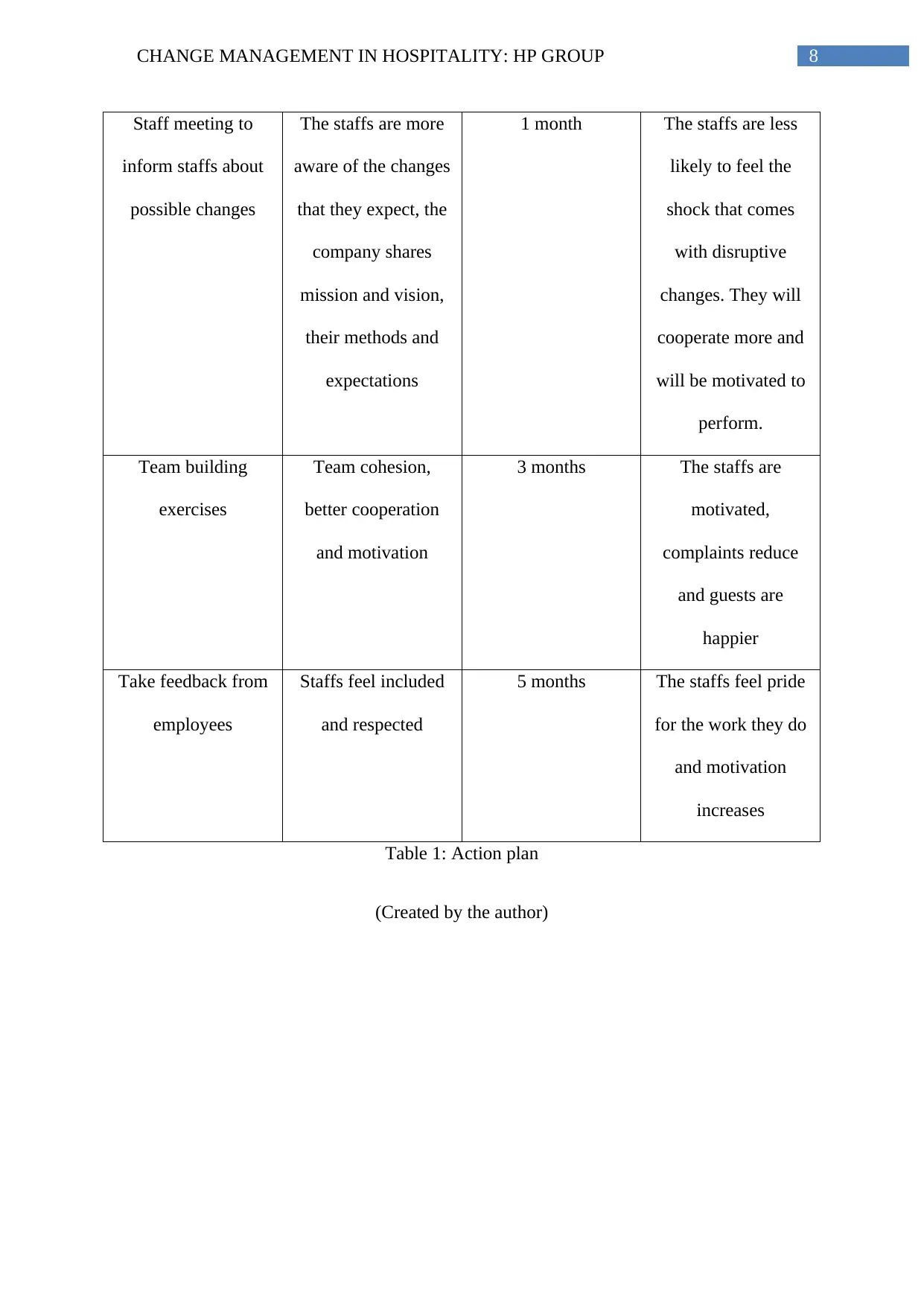
8CHANGE MANAGEMENT IN HOSPITALITY: HP GROUP
Staff meeting to
inform staffs about
possible changes
The staffs are more
aware of the changes
that they expect, the
company shares
mission and vision,
their methods and
expectations
1 month The staffs are less
likely to feel the
shock that comes
with disruptive
changes. They will
cooperate more and
will be motivated to
perform.
Team building
exercises
Team cohesion,
better cooperation
and motivation
3 months The staffs are
motivated,
complaints reduce
and guests are
happier
Take feedback from
employees
Staffs feel included
and respected
5 months The staffs feel pride
for the work they do
and motivation
increases
Table 1: Action plan
(Created by the author)
Staff meeting to
inform staffs about
possible changes
The staffs are more
aware of the changes
that they expect, the
company shares
mission and vision,
their methods and
expectations
1 month The staffs are less
likely to feel the
shock that comes
with disruptive
changes. They will
cooperate more and
will be motivated to
perform.
Team building
exercises
Team cohesion,
better cooperation
and motivation
3 months The staffs are
motivated,
complaints reduce
and guests are
happier
Take feedback from
employees
Staffs feel included
and respected
5 months The staffs feel pride
for the work they do
and motivation
increases
Table 1: Action plan
(Created by the author)
⊘ This is a preview!⊘
Do you want full access?
Subscribe today to unlock all pages.

Trusted by 1+ million students worldwide
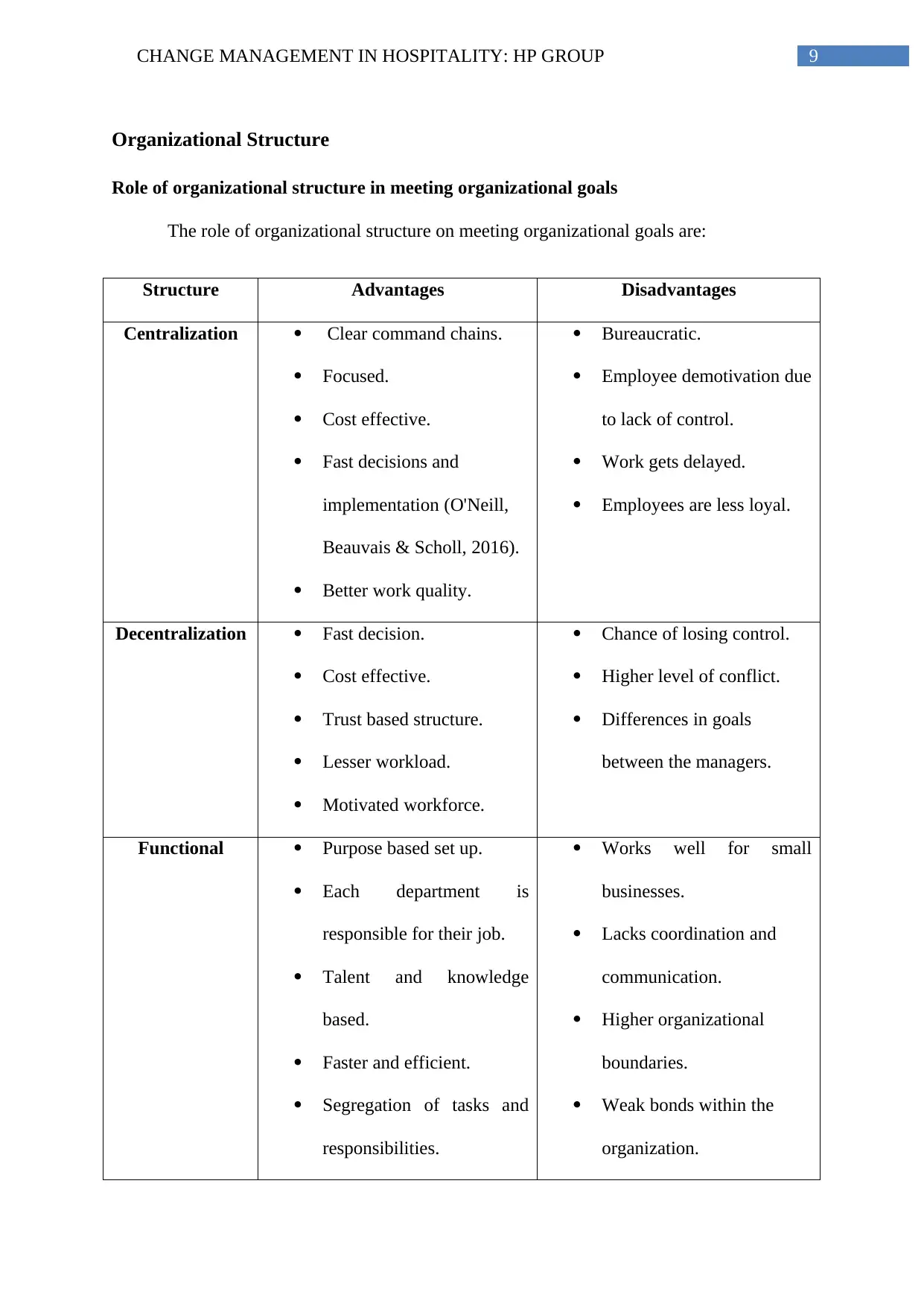
9CHANGE MANAGEMENT IN HOSPITALITY: HP GROUP
Organizational Structure
Role of organizational structure in meeting organizational goals
The role of organizational structure on meeting organizational goals are:
Structure Advantages Disadvantages
Centralization Clear command chains.
Focused.
Cost effective.
Fast decisions and
implementation (O'Neill,
Beauvais & Scholl, 2016).
Better work quality.
Bureaucratic.
Employee demotivation due
to lack of control.
Work gets delayed.
Employees are less loyal.
Decentralization Fast decision.
Cost effective.
Trust based structure.
Lesser workload.
Motivated workforce.
Chance of losing control.
Higher level of conflict.
Differences in goals
between the managers.
Functional Purpose based set up.
Each department is
responsible for their job.
Talent and knowledge
based.
Faster and efficient.
Segregation of tasks and
responsibilities.
Works well for small
businesses.
Lacks coordination and
communication.
Higher organizational
boundaries.
Weak bonds within the
organization.
Organizational Structure
Role of organizational structure in meeting organizational goals
The role of organizational structure on meeting organizational goals are:
Structure Advantages Disadvantages
Centralization Clear command chains.
Focused.
Cost effective.
Fast decisions and
implementation (O'Neill,
Beauvais & Scholl, 2016).
Better work quality.
Bureaucratic.
Employee demotivation due
to lack of control.
Work gets delayed.
Employees are less loyal.
Decentralization Fast decision.
Cost effective.
Trust based structure.
Lesser workload.
Motivated workforce.
Chance of losing control.
Higher level of conflict.
Differences in goals
between the managers.
Functional Purpose based set up.
Each department is
responsible for their job.
Talent and knowledge
based.
Faster and efficient.
Segregation of tasks and
responsibilities.
Works well for small
businesses.
Lacks coordination and
communication.
Higher organizational
boundaries.
Weak bonds within the
organization.
Paraphrase This Document
Need a fresh take? Get an instant paraphrase of this document with our AI Paraphraser
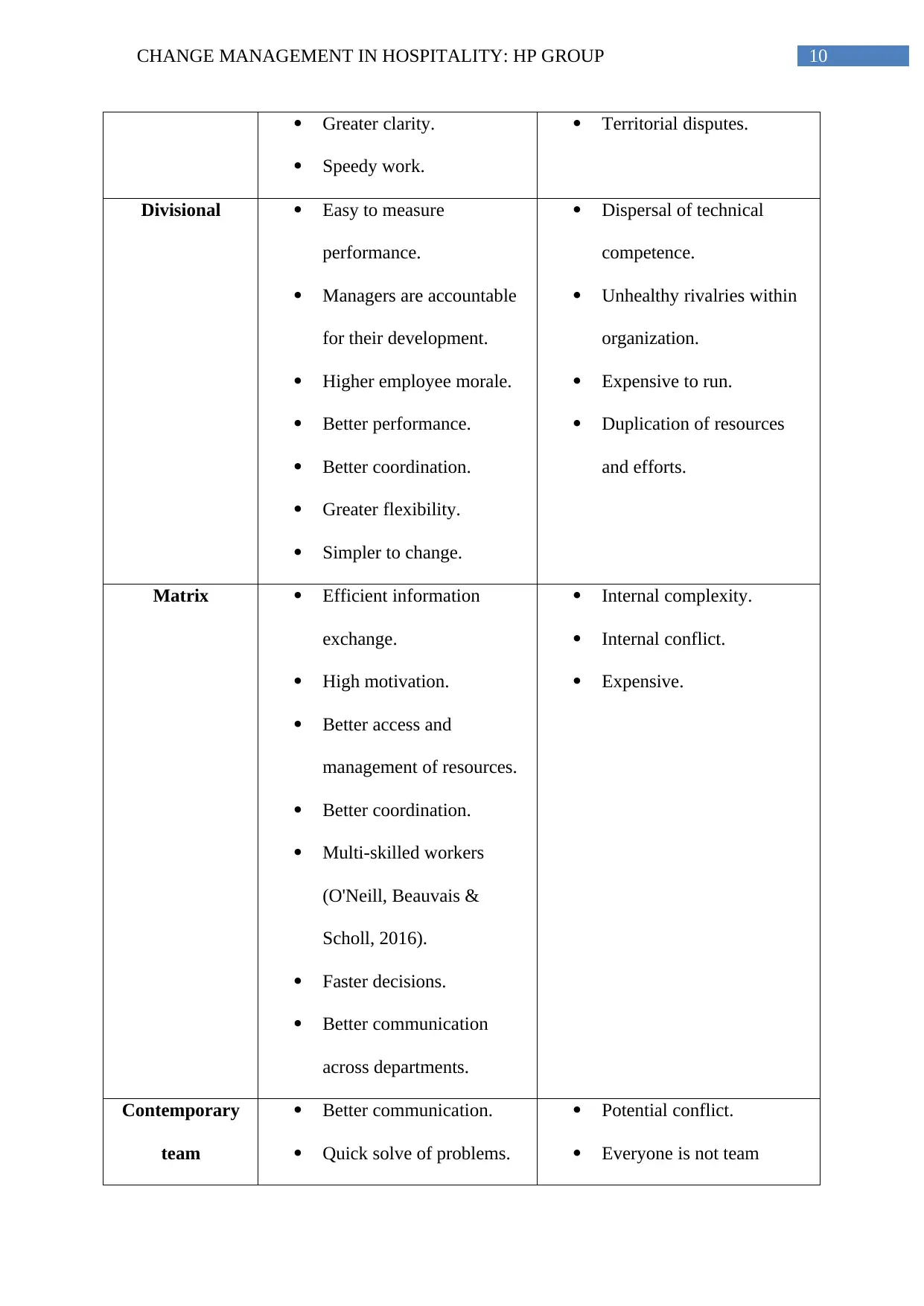
10CHANGE MANAGEMENT IN HOSPITALITY: HP GROUP
Greater clarity.
Speedy work.
Territorial disputes.
Divisional Easy to measure
performance.
Managers are accountable
for their development.
Higher employee morale.
Better performance.
Better coordination.
Greater flexibility.
Simpler to change.
Dispersal of technical
competence.
Unhealthy rivalries within
organization.
Expensive to run.
Duplication of resources
and efforts.
Matrix Efficient information
exchange.
High motivation.
Better access and
management of resources.
Better coordination.
Multi-skilled workers
(O'Neill, Beauvais &
Scholl, 2016).
Faster decisions.
Better communication
across departments.
Internal complexity.
Internal conflict.
Expensive.
Contemporary
team
Better communication.
Quick solve of problems.
Potential conflict.
Everyone is not team
Greater clarity.
Speedy work.
Territorial disputes.
Divisional Easy to measure
performance.
Managers are accountable
for their development.
Higher employee morale.
Better performance.
Better coordination.
Greater flexibility.
Simpler to change.
Dispersal of technical
competence.
Unhealthy rivalries within
organization.
Expensive to run.
Duplication of resources
and efforts.
Matrix Efficient information
exchange.
High motivation.
Better access and
management of resources.
Better coordination.
Multi-skilled workers
(O'Neill, Beauvais &
Scholl, 2016).
Faster decisions.
Better communication
across departments.
Internal complexity.
Internal conflict.
Expensive.
Contemporary
team
Better communication.
Quick solve of problems.
Potential conflict.
Everyone is not team
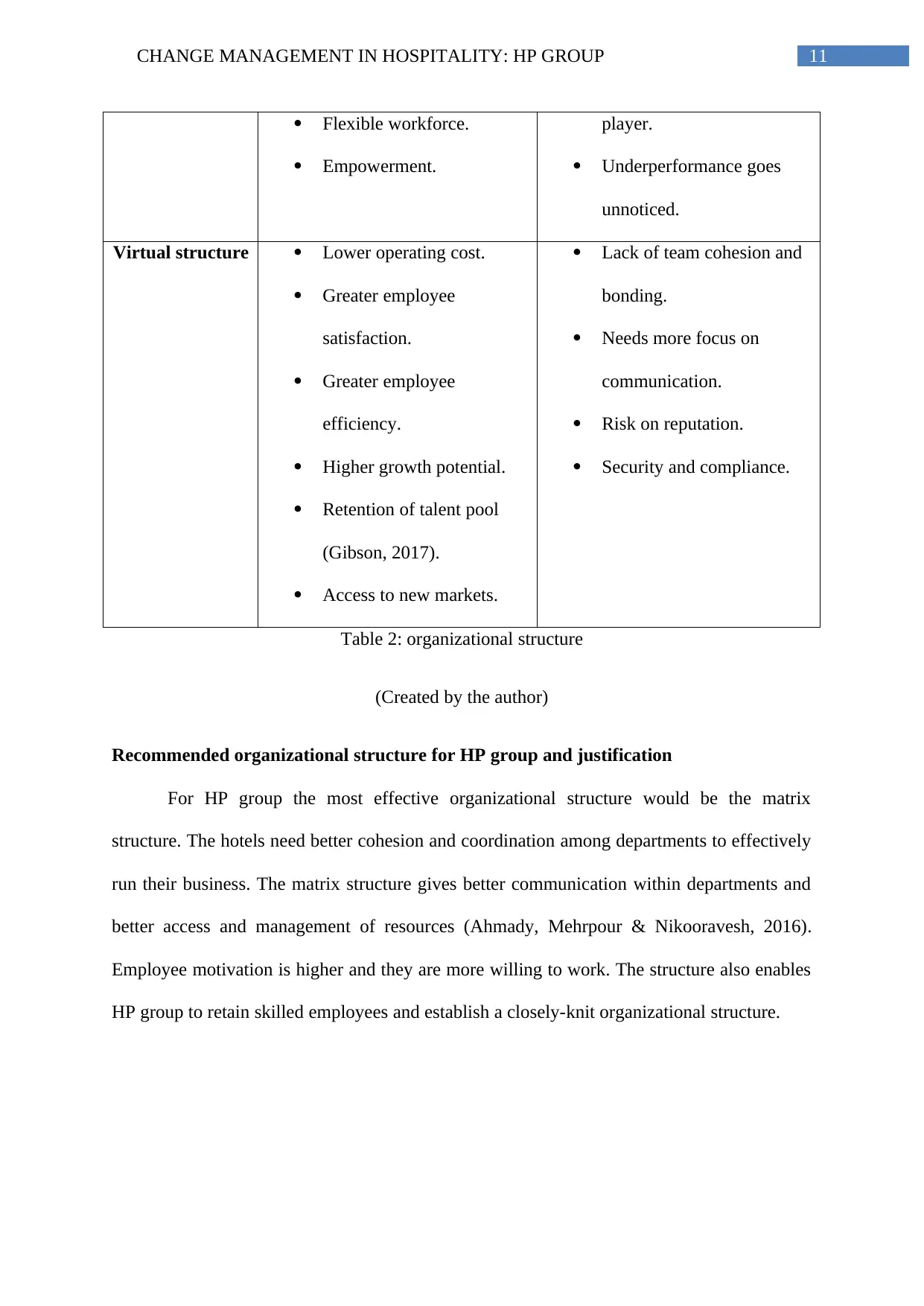
11CHANGE MANAGEMENT IN HOSPITALITY: HP GROUP
Flexible workforce.
Empowerment.
player.
Underperformance goes
unnoticed.
Virtual structure Lower operating cost.
Greater employee
satisfaction.
Greater employee
efficiency.
Higher growth potential.
Retention of talent pool
(Gibson, 2017).
Access to new markets.
Lack of team cohesion and
bonding.
Needs more focus on
communication.
Risk on reputation.
Security and compliance.
Table 2: organizational structure
(Created by the author)
Recommended organizational structure for HP group and justification
For HP group the most effective organizational structure would be the matrix
structure. The hotels need better cohesion and coordination among departments to effectively
run their business. The matrix structure gives better communication within departments and
better access and management of resources (Ahmady, Mehrpour & Nikooravesh, 2016).
Employee motivation is higher and they are more willing to work. The structure also enables
HP group to retain skilled employees and establish a closely-knit organizational structure.
Flexible workforce.
Empowerment.
player.
Underperformance goes
unnoticed.
Virtual structure Lower operating cost.
Greater employee
satisfaction.
Greater employee
efficiency.
Higher growth potential.
Retention of talent pool
(Gibson, 2017).
Access to new markets.
Lack of team cohesion and
bonding.
Needs more focus on
communication.
Risk on reputation.
Security and compliance.
Table 2: organizational structure
(Created by the author)
Recommended organizational structure for HP group and justification
For HP group the most effective organizational structure would be the matrix
structure. The hotels need better cohesion and coordination among departments to effectively
run their business. The matrix structure gives better communication within departments and
better access and management of resources (Ahmady, Mehrpour & Nikooravesh, 2016).
Employee motivation is higher and they are more willing to work. The structure also enables
HP group to retain skilled employees and establish a closely-knit organizational structure.
⊘ This is a preview!⊘
Do you want full access?
Subscribe today to unlock all pages.

Trusted by 1+ million students worldwide
1 out of 16
Related Documents
Your All-in-One AI-Powered Toolkit for Academic Success.
+13062052269
info@desklib.com
Available 24*7 on WhatsApp / Email
![[object Object]](/_next/static/media/star-bottom.7253800d.svg)
Unlock your academic potential
Copyright © 2020–2025 A2Z Services. All Rights Reserved. Developed and managed by ZUCOL.





